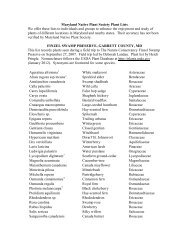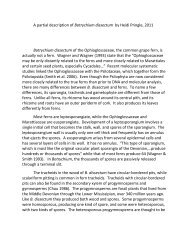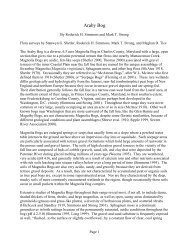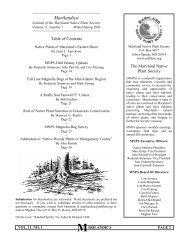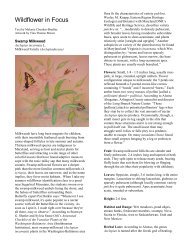Swamp Milkweed - Maryland Native Plant Society
Swamp Milkweed - Maryland Native Plant Society
Swamp Milkweed - Maryland Native Plant Society
Create successful ePaper yourself
Turn your PDF publications into a flip-book with our unique Google optimized e-Paper software.
Book Review<br />
By Jane Hill<br />
David Allen Sibley, e Sibley Guide to Trees.<br />
New York: Alfred A. Knopf, 2009. $39.95.<br />
Bruce Kershner, et al. National Wildlife Federation<br />
Field Guide to Trees. New York: Sterling<br />
Publishing Co., 2008. $19.95<br />
Two beautiful new field guides to North American<br />
trees have been published in the past two<br />
years. e more recent one, which appeared in<br />
September 2009, is by<br />
David Allen Sibley, who<br />
is well known as the<br />
author of numerous bird<br />
guides. is tree book,<br />
his fledgling venture into<br />
plant guides, follows the<br />
same format as his bird<br />
guides. It is comprehensive<br />
and attractively<br />
illustrated with his own<br />
paintings. It covers "668<br />
native and commonly<br />
cultivated trees found in<br />
the temperate areas of<br />
North America north of<br />
Mexico," including all<br />
native tree species except<br />
those limited to southern<br />
Florida. e National<br />
Wildlife Federation Field<br />
Guide to Trees of North<br />
America, published in<br />
2008, is illustrated solely<br />
with photographs. is multi-authored book<br />
covers native and non-native trees of North<br />
America north of Mexico, including (unlike<br />
Sibley) the trees of southern Florida, for a total<br />
of 700 species and varieties.<br />
Although Sibley has produced a good tree<br />
guide, he is not authoritative on the subject of<br />
trees. He makes errors, as, when, in defining a<br />
tree in his introduction, he states that box-elder<br />
is "usually multi-trunked (like a shrub)." He<br />
also calls Callery (Bradford) pear "naturalized,"<br />
although it is far better described as invasive, as<br />
the NWF guide labels it.<br />
Nevertheless, Sibley's treatment of escaped<br />
exotic trees is an advance over that of other field<br />
guides, including the NWF: Sibley provides<br />
range maps for these species. In contrast, the<br />
NWF guide, like most previous field guides to<br />
trees, includes maps for most of the native trees<br />
but none for the non-natives. In the NWF<br />
guide, the species accounts include some verbal<br />
information on the spread of exotics, but<br />
Sibley's approach enables a reader to comprehend<br />
at a glance where non-native trees are<br />
dispersing from cultivation. Unfortunately, the<br />
only way he distinguishes visually between<br />
natives and escaped exotics is by depicting<br />
native trees' ranges in a dull green, and exotic<br />
trees' ranges in a pale tan. e difference does<br />
not exactly jump off the page. In both guides,<br />
non-native trees could have been flagged by, say,<br />
marking their names with an asterisk in the<br />
species-account headings, or using a different<br />
typeface, as is common practice in technical<br />
manuals and floras. Older field guides to trees<br />
do no better in this regard, however.<br />
e two guides also contrast in their interpretations<br />
of species’ ranges. Sibley's range maps<br />
show where each species, native or not, "is<br />
known to be reproducing in the wild with no<br />
assistance from humans." e NWF guide<br />
shows what its authors call "natural geographic<br />
distribution" – presumably meaning historic,<br />
pre-European-settlement range. us, for such<br />
species as northern and southern catalpa<br />
(Catalpa speciosa and C. bignonioides), black<br />
locust, (Robinia pseudoacacia), and osageorange<br />
(Maclura pomifera), Sibley's guide shows<br />
much more extensive ranges than does the<br />
NWF book, because these species have spread<br />
widely from their pre-settlement distributions.<br />
Knowledge of both kinds of ranges is useful.<br />
For one thing, it provides fodder for discussions<br />
of what constitutes a "native" plant. Another<br />
difference is that the mapped ranges in the<br />
NWF guide present more detail. e NWF<br />
book shows two different ranges: where the<br />
species is "commonly or regularly found," and<br />
where distribution is "rare, scattered, or local."<br />
In Sibley, in contrast, there is only one mapped<br />
range, encompassing both kinds of distributions.<br />
e illustrations of tree parts present another<br />
contrast between the two guides. Sibley's<br />
paintings portray much<br />
more of the withinspecies<br />
variation, especi-<br />
ally in leaf and fruit<br />
forms, that can cloud<br />
identification. For exam-<br />
ple, for the tree he calls<br />
"common post oak"<br />
(Quercus stellata), Sibley<br />
shows seven examples of<br />
leaf shape, two of acorns,<br />
and two of twigs. For<br />
southern live oak (Q.<br />
virginiana), he depicts<br />
ten leaf shapes, four<br />
acorns, and a flowering<br />
and a nonflowering twig.<br />
In contrast, the NWF<br />
guide shows, for Q.<br />
stellata, only a single leaf,<br />
a single acorn, and no<br />
twig; and, for Q. virginiana,<br />
two photos of<br />
twigs, each bearing<br />
several leaves that do not represent well the<br />
wide variety in leaf form, and a photo of a pair<br />
of very similar acorns and no twig. (Both guides<br />
also show bark and overall tree form for these<br />
species.) Still, the NWF photos are plentiful<br />
and generally high quality, and often show<br />
plant parts more effectively than do Sibley's<br />
paintings. is is particularly true for bark,<br />
which in general Sibley renders much less<br />
successfully than he does leaves and fruits.<br />
A welcome feature of both guides is the<br />
inclusion of all the information for each species<br />
on the same page. is is more convenient than<br />
the organization of some older tree guides, such<br />
as Eastern Trees in the Peterson Field Guide<br />
series, or the National Audubon <strong>Society</strong> Field<br />
Guide to Trees, in which some of the illustrations<br />
are relegated to separate sections of the<br />
book.<br />
(continued on page 8)<br />
Marilandica Fall 2010 page 7




